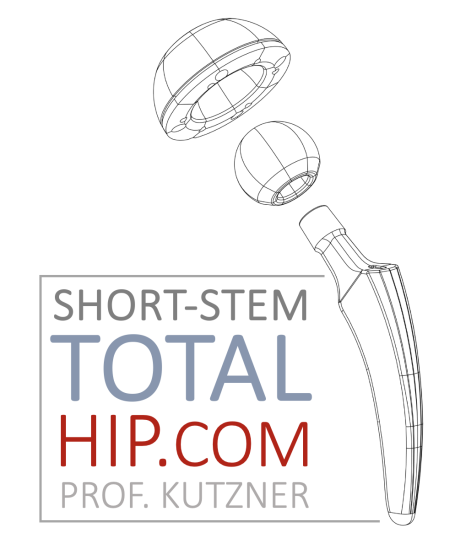The Wiesbaden Hip – Minimally Invasive Short Stem

What is the Wiesbaden Hip?
Why choose the Wiesabden Hip?
The Wiesbaden Hip represents a groundbreaking innovation in hip arthroplasty. This advanced approach combines minimally invasive surgery with the benefits of a short stem THA (optimys, Enovis), specifically designed to maximize bone preservation and significantly shorten recovery time. Developed in Wiesbaden, this technique marks a substantial improvement over traditional hip prostheses. Notably, the ENDOPROTHETICUM in Mainz under the leadership of Prof. Dr. Karl Philipp Kutzner and its close collaboration with the Lilium Clinic in Wiesbaden have perfected this technique.
The Wiesbaden Hip is a specific type of hip arthroplasty that employs a minimally invasive approach using a curved short stem prosthesis. This method was developed to minimize the stress and risks associated with conventional hip arthroplasty. The short stem requires less bone removal, which is especially beneficial for younger patients or those with good bone quality. This innovative method originates from Wiesbaden and is implemented by leading orthopedic surgeons and clinics in the region.
Advantages of the Minimally Invasive Short Stem Technique
The minimally invasive technique of the Wiesbaden Hip offers numerous advantages over conventional procedures. Here are some key benefits:
- Bone Preservation: The short stem allows for more of the natural bone to be preserved, which can lead to better long-term stability of the prosthesis.
- Faster Recovery: The minimally invasive approach causes less trauma to the surrounding tissue, leading to faster recovery and shorter hospital stays.
- Reduced Postoperative Pain: Patients report experiencing less pain postoperatively, reducing the need for pain medication.
- Improved Mobility: The preservation of bone and the precise placement of the prosthesis result in better mobility post-surgery.
The Wiesbaden Hip offers specific benefits that distinguish it from other hip prostheses. This method was developed to closely mimic the natural movement of the hip joint while enhancing the patient’s quality of life. Below are the specific advantages of this method:
- High Success Rate: The Wiesbaden Hip boasts a high success rate, primarily due to the combination of minimally invasive techniques and short stem prostheses.
- Customized Fit: The prosthesis is tailored to the individual patient, ensuring optimal functionality and longevity.
- Patient Testimonials: Many patients have reported positive outcomes, including improved quality of life and a quick return to daily activities.
The Wiesbaden Hip is particularly suitable for patients seeking a fast recovery and for whom bone preservation is a priority. Below are the specific indications for this method:
- Younger Patients: Due to its bone-preserving properties, this method is particularly suitable for younger patients.
- Active Patients: Individuals who lead an active lifestyle benefit from the improved mobility after surgery.
- Patients with Good Bone Density: This method is ideal for patients with good bone density, as the short stem makes the most of the bone’s natural structure.
The Surgical Process: What to Expect?
The surgical process for the Wiesbaden Hip is designed for efficiency and precision. Below is an overview of the procedure:
- Preoperative Preparation: Patients undergo comprehensive preparation, including detailed diagnostics and surgical planning. Prehabilitation plays a crucial role in preparing the body for the procedure.
- Surgery: The minimally invasive approach reduces the incision size and minimizes trauma to the surrounding tissue. The short stem is precisely implanted into the femur to ensure stable fixation.
- Postoperative Care: Following surgery, an individualized rehabilitation phase is tailored to the patient’s needs. The Lilium Clinic in Wiesbaden offers specialized rehabilitation programs to promote swift recovery.
Potential Risks and Complications
While the Wiesbaden Hip offers many advantages, it’s important to consider potential risks and complications:
- Prosthesis Loosening: As with all hip prostheses, there is a risk that the prosthesis may loosen over time.
- Infections: Despite the use of state-of-the-art techniques, there is a slight risk of postoperative infections.
- Misalignment: In rare cases, misalignment of the prosthesis may occur, necessitating a revision surgery.
Decision-Making Aid for Patients: Is the Wiesbaden Hip Right for You?
For patients uncertain whether the Wiesbaden Hip is the right choice, here’s a decision-making guide:
- Questions for Your Surgeon: What specific benefits does this method offer for my case? What is the success rate in my age group?
- Weighing Pros and Cons: Is bone preservation a central concern for me? How important is a quick return to my normal activity?
The Wiesbaden Hip represents a significant advancement in hip arthroplasty. Combining minimally invasive techniques with short stem prostheses, this method offers a promising solution for patients seeking high quality of life and rapid recovery. The close collaboration between the ENDOPROTHETICUM Mainz and the Lilium Clinic Wiesbaden ensures that patients receive the best possible care with cutting-edge technology.
Indications for the Wiesbaden Hip: Who Is It For?
The Future of Hip Arthroplasty – The Wiesbaden Hip
Wir benötigen Ihre Zustimmung zum Laden der Übersetzungen
Wir nutzen einen Drittanbieter-Service, um den Inhalt der Website zu übersetzen, der möglicherweise Daten über Ihre Aktivitäten sammelt. Bitte überprüfen Sie die Details in der Datenschutzerklärung und akzeptieren Sie den Dienst, um die Übersetzungen zu sehen.

